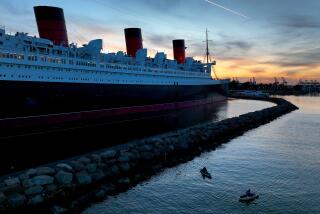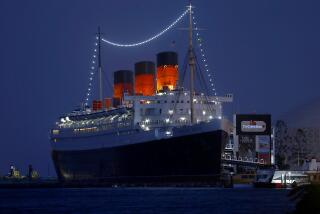Amid Expansion, Cruise Industry’s Outlook Sinks
- Share via
The U.S. cruise industry, which bet billions of dollars in ship-building money on expected growth this year and next, now faces tumbling stock values and an estimated 40% to 50% drop in bookings since last week’s terrorist attacks.
The cruise lines’ first response has been price cuts. This week Carnival Corp., the largest line, cut its lowest price for a three-day Carnival cruise from San Pedro to Ensenada by $50, to $249.
But analysts said further cuts will be harder because many lines already have been discounting deeply to spur slowing bookings this year.
Dependent on airlines to deliver more than half of their passengers to embarkation ports, cruise lines have suffered alongside the airline industry in the aftermath of the Sept. 11 attacks.
But unlike the airlines, the cruise industry is caught in the middle of a historic expansion. The industry is twice the size it was during the Gulf War, and even if it books as many customers as it did last year, its occupancy rates will drop sharply.
Recognizing the industry’s vulnerabilities, investors punished cruise stocks when Wall Street reopened Monday, sending shares of Carnival, Royal Caribbean Cruises Ltd. and P&O; Princess Cruises down 32% to 40%.
On Tuesday, the situation stabilized somewhat. Carnival rose 1% to $19.57, up 14 cents. Royal Caribbean dropped 7% to $11.81, down 95 cents. Princess was off 6%, or 78 cents, to $12.32, all on the New York Stock Exchange.
Even before Sept. 11, the industry was in a vulnerable position. Buoyed by several years of unbroken expansion in the 1990s, industry leaders ordered costly new ships--always a risky move, because the time between an order and a maiden cruise can be four years. When the economy slowed earlier this year, cruise lines quickly dropped prices to keep occupancy rates up.
The industry’s peak selling season is January to March, when most Caribbean cruises are booked. But the lines consider November and December a vital time for bookings of Mediterranean itineraries, a market that has emerged behind Alaska in popularity, often as an alternative for repeat cruisers.
Now, agents said, geography and timing make those sailings the most economically vulnerable. Conversely, cruise executives say, bookings are higher and cancellations lower on cruises that attract passengers who drive, rather than those who fly.
At Miami-based Carnival, Chairman and CEO Micky Arison said that since Sept. 11, the company’s bookings have dropped to 60% of typical levels for this time of year. Arison said he expects Carnival to remain profitable in the fourth quarter.
At Royal Caribbean, CEO Richard Fain said that on the Wednesday, Thursday and Friday after the attacks, the cruise line “took approximately 50% of bookings we took during the same three days in the prior week.” He forecast $20 million in losses for the week following Sept. 11.
The central problem cruise lines face, travel agents and Wall Street analysts agreed, is how the companies will handle growing inventory in a protracted slump. The challenge is further complicated by the cruise lines’ dependence on air travel. Most cruise passengers fly to reach their embarkation points, and forecasters are uncertain when airline traffic will recover.
Market leader Carnival, which sails 44 ships under six brand names, has 14 ships with a total value of $6.2 billion under contract to be built between now and December 2004. The company also broke ground in late July on a $40-million cruise complex in Long Beach, to be completed in early 2003.
Carnival spokeswoman Jennifer de la Cruz said there have been no changes in those plans. On Monday the company dropped its lowest rates on several cruises.
In the absence of military action, some agents suggested, cruise lines could recover more quickly than airlines because many travelers perceive a cruise as a pleasant but controlled environment with a strong safety record.
De la Cruz said that after the 1991 Gulf War, cruise industry business rebounded “pretty quickly. We’re hopeful that we’ll see a quick rebound this time as well.”
But because of the number of ships coming on line, simply regaining lost customers will leave occupancy rates lagging.
“Bookings are clearly slow,” said Mike Driscoll, editor of Wilmington, N.C.-based Cruise Week, a trade publication for travel agents. Referring to the cruise line reports of 50% drops, Driscoll said, “Some of the agents I’ve talked to say it’s larger than that.
“They’re clearly going to have to drop prices to stimulate demand,” he said. “But there’s still the air component in question.”
Driscoll said the industry’s troubles could trigger a rapid consolidation among the 20 small lines that share the approximately 25% of the market not taken by Carnival, Royal Caribbean and Princess.
Among the big three, Santa Clarita-based Princess Cruises faces one of the most daunting lists of inventory on order. Princess, which operates 10 ships, has five under construction in shipyards in Europe and Asia. They’re due to enter service between now and 2004, beginning with the $450-million Star Princess, which in March is scheduled to begin regular sailings to Mexico from Los Angeles.
Princess President Phil Kleweno said that on the four Princess ships that began new itineraries last weekend (three in Alaska, one in Florida), occupancy was about 90%. He declined to say how bookings since Sept. 11 have compared with last year, nor would he comment on the line’s flexibility when it comes to ships on order.
*
RELATED STORY
Airlines’ appeal: Executives ask the Bush administration and Congress for federal aid. A3
More to Read
Inside the business of entertainment
The Wide Shot brings you news, analysis and insights on everything from streaming wars to production — and what it all means for the future.
You may occasionally receive promotional content from the Los Angeles Times.











